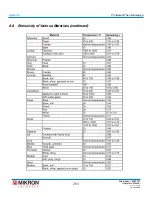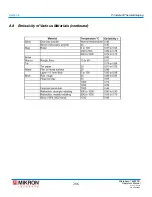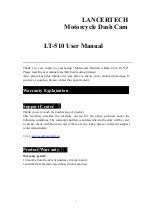
Section 7
Advanced Operations
271
MikroScan 7600PRO
Operator’s Manual
Catalog 11180-94
V15.4F 050406
4) Toggle the
jOyStICK
to the right to highlight the
IEEE 1394
option.
[Ieee 1394 OPtIOn HIGHLIGHted]
5) Toggle the
jOyStICK
up or down as needed to select the desired
IEEE 1394 option.
The IEEE 1394 options are:
• On [Ieee1394 supported] (deFAuLt)
• OFF [Ieee1394 no supported]
6) Press the
jOyStICK [e]
button to lock the setting and to return to
the main display.
7.4 Calibrating the Instrument
The calibration function has two modes: REF CAL and ERSP CAL.
The two
CALIbRAtIOn
modes are as follows:
Mode
Functon
ReF CAL
The REF CAL (Reference Calibration) mode is used when the sur-
face to be measured has a low emissivity (high reflectivity) and the
surface temperature is low or close to ambient.
It is also used when the surface is reflecting energy originating from
ambient conditions or some other source that cannot be shielded or
compensated for by use of the emissivity setting. To correct for the
error, the MikroScan 7600PRO is first aimed at the ambient or other
source of error. It then generates a compensation signal to correct all
subsequent measurements of the same scene.
eRSP CAL
The ERSP CAL (External Response Calibration) mode is used when
the instrument is being operated in ambient temperatures close to
the upper (40°C) or lower (0°C) ambient limits of the instrument’s
operation specification. The use of a blackbody source capable of
temperatures in excess of 60°C to 70°C is recommended. In per-
forming this calibration, REF CAL is performed in advance.
Users who are not famil-
iar with terms such as
emissivity, reflectance,
and blackbody are recom-
mended to read the section
on Principles of Infrared
Temperature Measurement
in Section 8 of this manual.
Users who are not famil-
iar with terms such as
emissivity, reflectance,
and blackbody are recom-
mended to read the section
on Principles of Infrared
Temperature Measurement
in Section 8 of this manual.
Summary of Contents for 7600PRO
Page 2: ......
















































